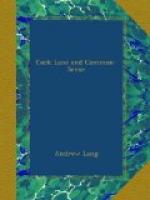state of mind which accompanied the Civil War, was
a furious persecution of ‘witches’.
In a rare little book, Select Cases of Conscience,
touching Witches and Witchcraft, by John Gaule, ’preacher
of the Word at Great Staughton in the county of Huntington’
(London, 1646), we find the author not denying the
existence of witchcraft, but pleading for calm, learned
and judicial investigation. To do this was to
take his life in his hand, for Matthew Hopkins, a
fanatical miscreant, was ruling in a Reign of Terror
through the country. The clergy of the Church
of England, as Hutchinson proves in his Treatise of
Witchcraft (second edition, London, 1720), had been
comparatively cautious in their treatment of the subject.
Their record is far from clean, but they had exposed
some impostures, chiefly, it is fair to say, where
Nonconformists, or Catholics, had detected the witch.
With the Restoration the general laxity went so far
as to scoff at witchcraft, to deny its existence,
and even, in the works of Wagstaff and Webster, to
minimise the leading case of the Witch of Endor.
Against the ‘drollery of Sadducism,’ the
Psychical Researchers within the English Church, like
Glanvill and Henry More, or beyond its pale, like
Richard Baxter and many Scotch divines, defended witchcraft
and apparitions as outworks of faith in general.
The modern Psychical Society, whatever the predisposition
of some of its members may be, explores abnormal phenomena,
not in the interests of faith, but of knowledge.
Again, the old inquirers were dominated by a belief
in the devil. They saw witchcraft and demoniacal
possession, where the moderns see hysterics and hypnotic
conditions.
For us the topic is rather akin to mythology, and
‘folk-psychology,’ as the Germans call
it. We are interested, as will be shown, in a
most curious question of evidence, and the value of
evidence. It will again appear that the phenomena
reported by Glanvill, More, Sinclair, Kirk, Telfair,
Bovet, are identical with those examined by Messrs.
Gurney, Myers, Kellar (the American professional conjurer),
and many others. The differences, though interesting,
are rather temporary and accidental than essential.
A few moments of attention to the table talk of the
party assembled at Ragley will enable us to understand
the aims, the methods, and the ideas of the old informal
society. By a lucky accident, fragments of the
conversation may be collected from Glanvill’s
Sadducismus Triumphatus, {88a} and from the correspondence
of Glanvill, Henry More, and Robert Boyle. Mr.
Boyle, among more tangible researches, devoted himself
to collecting anecdotes, about the second sight.
These manuscripts are not published in the six huge
quarto volumes of Boyle’s works; on the other
hand, we possess Lord Tarbet’s answer to his
questions. {88b} Boyle, as his letters show, was
a rather chary believer in witchcraft and possession.
He referred Glanvill to his kinsman, Lord Orrery,
who had enjoyed an experience not very familiar; he
had seen a gentleman’s butler float in the air!




